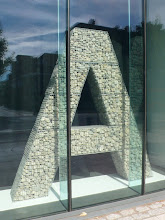41 Kingsland High Street
Stir fried noodles with vegetables
and a bottle of water
Housed in a former pie & mash shop*, with a listed interior, Shanghai is a palimpsestual, cross-cultural mix of a place. Its walls retain the mirrors—complete with intertwined pairs of brass eels fixed to each side—and ceramic tiles.


The ones behind the counter depict boats that presumably are of the type that would have caught the eels. The main seating in the front area is church bench like, with a row of bar stools at the counter. I order a still water, as there are no Chinese soft drinks on the menu, and stir fried noodles. The water arrives in a fancy glass bottle sporting a Barnbrook typeface on its label.

There are four other customers in, and sixties and seventies American pop plays over the sound system—the Mamas and Papas, Harry Nillson—the waitress occasionally sings along, and she and the guy behind the counter exchange the odd word in a language I don’t understand.
My food arrives. The noodles are big and fat and are interspersed with strips of onion, carrot and cabbage. It looks a bit anaemic. I feel like I can’t be bothered to use the chopsticks that are in a pot on the table, and am drawn to the spoon and fork which each table is set up with, but I resist.

The table setting is perhaps an indication of their predominant customers. The noodles are floury tasting and slightly chewy. The other overwhelming taste is that of salty soy sauce. At the end of the room a large stone Buddha sits serenely on top of a cabinet that is full of other, smaller statues, which I assume are gods of some kind. The music shifts to eighties British stuff—the Police, Phil Collins—middle of the road elevator music that doesn’t interfere until you start listening to it, then it adds another layer to the confusing sensory experience. Given research into what makes a successful ‘ethnic’ restaurant, I am surprised Shanghai took this place on as they are so restricted in what they are able to do with the decor. On the way to the toilet, I see the back room tables are laid with chopsticks and two tables of Chinese people are eating. Is this some kind of culinary apartheid? On paying I ask the waiter if the china figures are gods. Yes, he says and explains that they are to do with wealth and success. As I walk out of the door I pass over the mosaic tiled step that reads COOKE ESTABLISHED 1862. I wonder if they lasted longer than Shanghai will?

(Photo by http://www.flickr.com/photos/sarflondondunc/3458054241/)
*East end pie and mash shops
The first eel-pie shops didn’t appear until the early 19th century, just before Queen Victoria came to the throne. They sold pies filled with meat or eels, and stewed eels and began to serve the pies with mashed potato, as this was a cheap, staple food. By 1874 there were 33 such shops listed. The eel pie and mash shops became very popular with the poor working classes, as they served hot nourishing meals very cheaply. The shops began to flourish and spread across the East end of London, where the main body of poor working class lived and worked, and Pie & Mash became entrenched in Eastend culture. Licquor was, quite simply, the liquid left over from stewing or boiling eels. This was often made into a sauce or gravy by addition of herbs, particularly parsley which was a natural accompaniment to fish dishes. It was quite a natural step for them to serve this green gravy with their eels and mash.
A lot of pie and mash fans will tell you that they only use a fork and spoon and that it’s hardly de rigueur to use a knife. According to an interview with Fred Cooke in 1989 there was a shortage of knives during World War I and customers of such establishments nicked the knives, so only forks and spoons were available. However, in a subsequent Channel 4 interview with an Emily Giggins, who was born in 1908 and has eaten at Cooke’s since she was a young girl, she says that ‘knives were banned because of fighting between the customers’. Well, whatever the reason, using a fork and spoon has became a tradition.
www.pie-and-mash.com


No comments:
Post a Comment